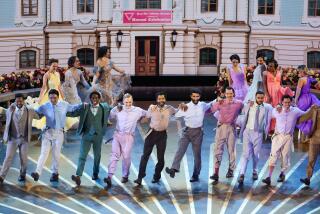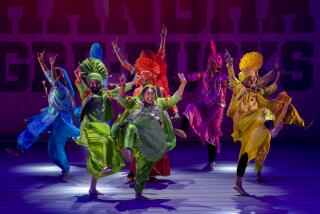India’s Independence Shares Spotlight With One Dancer
- Share via
Originally planned to celebrate 50 years of India’s independence, “Bharat-Sanskriti” also became a tribute to Mother Teresa by the time it premiered at the Cerritos Center for the Performing Arts on Saturday. And it ended having another major agenda as well: showcasing the 19-year-old daughter of the woman who conceived and directed this spirited, sprawling three-hour compendium of great moments from Indian history and literature.
Director Anjani Ambegaokar, a locally based specialist in Kathak, one of the ancient classical dance idioms of India, invited exponents of Odissi, Bharata Natyam and Kuchipudi classicism to dance in her cavalcade--sometimes literally alongside her own company. The result allowed even newcomers to appreciate major differences between the forms: the angular, arrowy attack of Bharata Natyam in contrast to the rounded, sensuous undulation of Odissi, for example. Unfortunately, several distinguished guest artists failed to appear (reportedly because of last-minute visa problems), and their absence left the 17-part program without a single male dancer.
Worse, it overexposed her teenage daughter, Amrapali Ambegaokar. To be fair, their “Mahabharata” duet proved one of the evening’s highlights, with mother and child dancing brief, artful abstractions of key episodes from this Hindu epic while company members formed more literal tableaux upstage. However, casting Amrapali as Shiva and Durga in major solos elsewhere did her no favor. For all her radiance, as well as her mastery of the technical wonders of Kathak, she is not yet a dancer of sufficient dramatic power to convincingly embody these fierce deities. Thus, she was outclassed by some of the more seasoned guests.
Nandita Behra, for instance, colored each of her Odissi solos exquisitely, with her superbly modulated pantomime in the “Gitanjali” sequence perhaps the most memorable achievement of the evening. Swetha Bharadvaj brought vivacity and expressive detail to her Kuchipudi portrayal of the goddess Parvati. Finally, her mother, Ramaa Bharadvaj, used the deepest resources of Bharata Natyam storytelling to depict enduring issues of human cruelty in “Shankaracharya.”
“Bharat-Sanskriti” finished with the Ganges equivalent of a tap jam: dancers challenging one another’s ability to pick up complex step-rhythms on the spot, from Kathak to Bharata Natyam to Odissi. More than a dozen excellent musicians added their artistry to the event. Unfortunately, delays between sequences and technical glitches compromised everyone’s effectiveness.
More to Read
The biggest entertainment stories
Get our big stories about Hollywood, film, television, music, arts, culture and more right in your inbox as soon as they publish.
You may occasionally receive promotional content from the Los Angeles Times.










